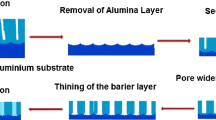Abstract
High aspect ratio nanowires of Ni–Cu alloys have been synthesized by potentiostatic electrochemical deposition in etched ion-track membranes. The nickel-to-copper ratio in the nanowires was controlled via the deposition potential and electrochemical bath composition. We present a detailed study of nanowire properties including morphology, composition, and magnetic behavior. We report the magnetic configurations measured as function of the nanowire composition and discuss domain formation, anisotropy aspects, and local easy axis distributions.





Similar content being viewed by others
References
Beleggia M, Tandon S, Zhu Y, De Graef M (2004) On the magnetostatic interactions between nanoparticles of arbitrary shape. J Magn Magn Mater 278:270–284
Enculescu I, Toimil-Molares ME, Zet C (2007) Current perpendicular to plane single-nanowire GMR sensor. Appl Phys A 86:43–47
Fert A, Piraux L (1999) Magnetic nanowires. J Magn Magn Mater 200:338–358
Gravier L, Wegrowe J-E, Wade T et al (2002) Thermopower and GMR of a single Co–Cu multilayer nanowire. IEEE Trans Magn 38:2700–2702
Kronmuller H, Durst KD, Sagawa M (1988) Analysis of the magnetic hardening mechanism in RE-FeB permanent magnets. J Magn Magn Mater 74:291–302
Kuncser V, Keune W (2011) Step-shape angular spin distribution in layered systems by 57Fe Mossbauer spectroscopy: a general treatment. J Magn Magn Mater 323:2196–2201
Kuncser V, Keune W, Vopsaroiu M et al (2003) Easy axis distribution in modern nanoparticle storage media: a new methodological approach. J Optoelectron Adv Mat 5:217–226
Kuncser V, Schinteie G, Palade P et al (2010) Magnetic properties of Fe–Co layers and Fe–Mn/Fe–Co bilayers obtained by thermo-ionic vacuum arc. J Alloys Compd 499:23–29
Mansuripur M (1995) The physical principles of magneto-optical recording. Cambridge University Press, Cambridge
Martin CR (1994) Nanomaterials—a membrane-based synthetic approach. Science 266:1961–1966
Matei E, Ion L, Antohe S, Neumann R, Enculescu I (2010) Multisegment CdTe nanowire homojunction photodiode. Nanotechnology 21:105202
Michels A, Weissmuller J, Widenmann A, Barker JG (2000) Exchange-stiffness constant in cold-worked and nanocrystalline Ni measured by elastic small-angle neutron scattering. J Appl Phys 87:5953–5955
Ney A (2011) Magnetic properties of semiconductors and substrates beyond diamagnetism studied by superconducting quantum interference device magnetometry. Semicond Sci Technol 26:064010
Ohgai T, Gravier L, Hoffer X et al (2003) Template synthesis and magnetoresistance property of Ni and Co single nanowires electrodeposited into nanopores with a wide range of aspect ratios. J Phys D 36:3109–3114
Ozin GA (1992) Nanochemistry: synthesis in diminishing dimensions. Adv Mat 4:612–649
Richter A, Eschrig H (1988) LCAO-CPA for disordered ferromagnetic 3d transition metal alloys. Magnetic moment formation in NiCu and FeCo. Phys Scr 37:948–951
Ross CA, Hwang M, Shima M et al (2002) Micromagnetic behavior of electrodeposited cylinder arrays. Phys Rev B 65:144417
Sellmeyer DJ, Zheng M, Skomski R (2001) Magnetism of Fe, Co and Ni nanowires in self-assembled arrays. J Phys Condens Matter 13:R433–R460
Sugawara A, Streblechenko D, McCartney M, Scheinfein MR (1998) Magnetic coupling in self-organized narrow-spaced Fe nanowire arrays. IEEE Trans Magn 34:1081–1083
Toimil Molares ME, Buschmann V, Dobrev D, Neumann R, Scholz R, Schuchert IU, Vetter J (2001) Single-crystalline copper nanowires produced by electrochemical deposition in polymeric ion track membranes. Adv Mat 13:62–65
Yi G, Schwarzacher W (1999) Single crystal superconductor nanowires by electrodeposition. Appl Phys Lett 74:1746–1748
Acknowledgments
The financial support through the exploratory research project PCE IDEI 75/2011 is highly acknowledged.
Author information
Authors and Affiliations
Corresponding authors
Rights and permissions
About this article
Cite this article
Matei, E., Enculescu, I., Toimil-Molares, M.E. et al. Magnetic configurations of Ni–Cu alloy nanowires obtained by the template method. J Nanopart Res 15, 1863 (2013). https://doi.org/10.1007/s11051-013-1863-3
Received:
Accepted:
Published:
DOI: https://doi.org/10.1007/s11051-013-1863-3




